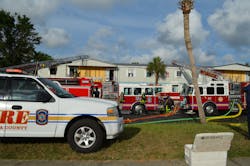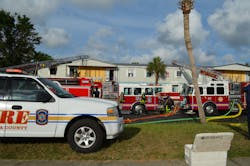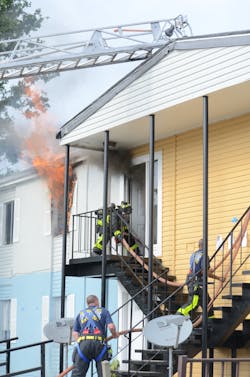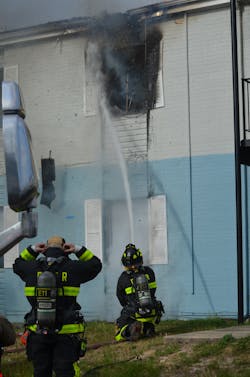Command & Control Success: When to Deviate from Foundational Tactics
The fire service is built on foundational tactics of firefighting that have been refined and proven over the past 100 years to work and control fires most of the time. However, there are rare exceptions where circumstances exist that require a fireground commander to go outside of the foundational tactics to control and suppress challenging fires. I refer to this as graduating beyond the basics of everyday firefighting.
Fireground commanders must recognize when to deviate from time-proven tactics. Departing from an established course or accepted standard must be a conscious decision that’s based on the circumstances at hand.
One circumstance that could prompt deviation is staffing—either not enough or so much as to permit doing something specialized or both. More frequently, it’s the lack of staffing that requires something different to achieve what normally is completed with standardized/accepted staffing levels under NFPA standards.
Staffing & deviation
Most of the strategy and tactics manuals from the past decades were written by experienced urban firefighters. The accepted foundation of firefighting is based on these manuals. That said, a large part is based on the frequency of fire duty and the ability to fine tune.
FDNY is a great example of foundational tactics and company assignments becoming standardized and fine-tuned—for instance, “Ladders 3,” by Battalion Chief John O’Regan, on what companies do based on arrival at apartment, aka tenement, fires. O’Regan got Fire Chief John O’Hagan to incorporate the “Ladders 3” strategies and tactics as the standard.
As months and years passed, O’Hagan required that strategies and tactics be written for other types of occupancies in the effort to help to standardize how everyone in the department operated at those occupancies. The written plans were based on FDNY staffing and response models. Before these playbooks regarding who, what, when and where existed, it was a free-for-all, with freelancing during operations regarding who wanted to do what not uncommon.
So, yes, like FDNY’s written plans, the strategies and tactics that are found in books are fireground-proven. However, once again, they are, for the most part, derived from experiences that are associated with the large urban staffing response model. County fire services, which protect everything from rural and suburban to somewhat urban communities, with firehouses spread far apart and, more times than not, less-than-desirable staffing, must adapt and deviate their strategies and tactics to complete the mission of fire suppression and saving lives.
Sometimes, this might be stretching two hoselines simultaneously, with each line staffed by one or two people: one line to the point of entry and one to the location where fire is venting out of a window.
The line to the window can be used to start water application immediately with only one person assigned to the line. If the stream is directed properly into the horizontal opening and on a straight or solid stream, this undoubtedly will assist in fire suppression while only obligating one firefighter.
The line to the point of entry can be set properly and charged, bled properly and made ready for entry for when the staffing that’s necessary for all of the pinch points is available. This staffing might include driver/operators from different apparatus and/or even a chief officer if no one else is available. This will assist in getting water on the fire quicker without hampering the chief’s primary duties.
This definitely isn’t ideal, and foundational tactics tell us stretch one line at a time and to make sure that a line is staffed properly before stretching additional lines or in series. However, when staffing isn’t available, fireground commanders must know how to deviate to get the best outcome possible, while always working toward decades of proven foundational tactics.
Another example is using specialized nozzles on an attic fire or void space fire when staffing isn’t available to pull ceilings or to cut proper size vent holes.
The decision to use a specialized nozzle also could be based on construction or modifications, such as in Photo 1 (previous page), which shows a homemade floor below nozzle being raised to the roof to suppress a stubborn fire that’s between the structure’s original flat tar-and-gravel roof and a pitched roof that was added over it. A rubber membrane on the pitched roof was over the entire apartment building.
The homemade floor below nozzle was dropped into a small vent hole to apply water between the two roofs.
Fire growth’s effect
Sometimes, departments must deviate frequently—and almost as a policy—based on response times and staffing. I wrote in previous Firehouse articles and columns about how more and more departments might have numerous fire apparatus report directly to the scene to boost staffing before securing a sustained water supply. This primarily is for life safety of civilians—in other words, staffing for search—but it also helps to confirm that there are enough firefighters to tactically deploy and stop fire growth sooner rather than later.
Remember, you must have enough firefighters on scene to actually use the booster tank water before you even need to tap into hydrant water.
Today, there is less time to flashover than there was 40–50 years ago. When firefighting manuals were written, the fire service sent pumpers, hose tenders and ladder companies, with a bunch of firefighters hanging off of the sides, to fires. The potential for flashover could be as long as 20 minutes or more. Today, four minutes might be the maximum before flashover.
The majority of the fire service staffs fire companies with four or fewer firefighters per fire apparatus. In this day and age when a fire is growing three times faster than in the past and the number of firefighters that arrives per apparatus is sometimes half what it was, we must be prepared to deviate for command success.Deviation in action
Photo 2 shows a full box alarm assignment for an apartment fire. I arrived shortly after the first-arriving engine company pulled up. I directed the second-, third- and fourth-arriving fire companies to come directly into the scene and position for full potential of what the incident could become. It was the fifth-arriving fire company that was an engine company that laid a supply line and hooked directly to the second-arriving engine. This provided water to fill the first-due and second-due engines’ booster tanks. It also provided an additional engine for stretching lines off of and built in a second pump to the operation.
The green 3-inch hose is a feeder line that provided water to an additional engine that was assigned as a RIT engine but actually was the engine that flowed water from the exterior through the second-floor window. I directed them to do this after an extended period of no change. The fire that was venting out of the second floor extended to the complex attic space. I could see from the command post (the back of my vehicle) that the primary attack line (Photo 3) was almost in the apartment based on coupling location. This fact, combined with the amount of time that had passed and the attack engine officer stating that he was having problems locating the room of fire, called for some deviation of tactics until the interior line could locate the room of fire.The RIT engine line flowed from the exterior at an angle and used a stream that wouldn’t push fire, stop fire from continuing to vent or cause harm to any firefighters who operated on the interior. This also assisted with the fire that was burning on the combustible exterior siding and where the fire had extended into the attic space. This line wasn’t used to fully extinguish the interior fire but to maintain it and to provide additional time for the interior line to complete full extinguishment, while also stopping interior fire spread.
This was a larger-than-normal, three-bedroom apartment, yet this fire was contained to the bedroom of origin. The apartment was repaired and reoccupied within a couple of months.Predictable is preparable
To achieve command success, you must evaluate past practices and future challenges continually to be open to all options that are necessary to save lives and stop property loss. Try to predict your challenges based on your buildings and staffing, so you can prepare strategic and tactical options to best mitigate your more challenging fires. You might need to deviate at your next fire.
Unconventional: Water Flowed on Opposite Side of Fire Wall
At a fire at a three-story motel in the late 90s, a trench was cut on the opposite side of the masonry fire wall. Once the cut was made, we saw fire penetrating through a bunch of breaches in the fire wall.
Without the staffing to get a hoseline to the top floor, to pull the ceilings and to apply water from underneath, I dropped a personal rope that I carried in my pocket down to the parking lot. Members hooked an attack line to it. We pulled it up, so we could flow water through the vertical trench-style cut to keep the fire from spreading into the next part of the motel. This line assisted the fire wall in maintaining the fire to the side where it originated.
The side of the motel that we kept the fire from spreading to still is in business today; the side of the motel where the fire originated was turned into additional parking.
Cutting a trench-style hole on the wrong side of a fire wall isn’t ideal, nor is applying water through a vertical vent opening that’s made by the fire department. However, in this incident, it was necessary to deviate from foundational tactics based on limited staffing, building construction features, extent of fire and how long the fire had been burning. The outcome was better than if we unwaveringly adhered to what’s written in firefighting manuals.
A Time and Place to Break the Rules
When deviation is applied on the fireground, it’s critical that the fireground commander fully understand the reasons for foundational tactics and their when, why and where. These people must be well versed in all tactics and how they apply based on building construction, staffing and weather conditions. Only then are they in the best position possible to know when it’s necessary to deviate—based on the circumstances not allowing traditional, time-tested tactics to give the best overall outcome.
Miscalculation of tactics can be costly. One big example: Using positive pressure fans to protect an attached exposure by pressurizing it via a large amount of cubic feet per minute. If properly used, this can help stop interior fire spread. However, it also can increase the fire’s intensity greatly, such as is the case when a significant wind blows.
A large number of line-of-duty deaths occurred when chief officers failed to deviate, because their knowledge was based on strategies and tactics from decades before. They failed to study tactical options that have become accepted and proven to work. The latter has resulted from everyone having radios, thermal imagers and better understanding of fire behavior thanks to UL's Fire Safety Research Institute.
About the Author

Curt Isakson
Curt “Ike” Isakson is a 30-plus-year veteran of the fire service. He worked for Escambia County, FL, Fire Rescue for 25 years. Isakson previously worked nine years for the Pensacola, FL, Fire Department, where he was assigned as a company officer on Heavy Rescue 31. His fire service experience started at a young age as a junior firefighter with the Midway, FL, Fire District; he rose through the ranks to captain. Isakson's identification of the need for a series of special-interest fire conferences spawned the development of County Fire Tactics, which covers officer development, command officers, water on fire, high-rise operations, and leadership and tactics.



